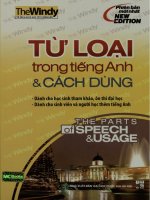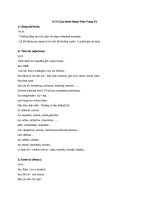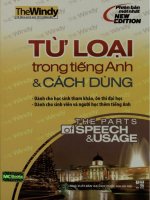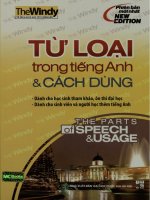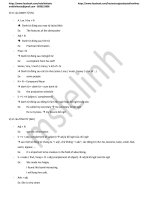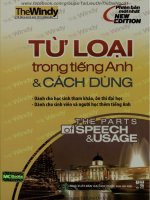TỪ LOẠI TRONG TIẾNG ANH
Bạn đang xem bản rút gọn của tài liệu. Xem và tải ngay bản đầy đủ của tài liệu tại đây (103.69 KB, 7 trang )
TỪ LOẠI TRONG TIẾNG ANH
Có mấy loại từ loại trong tiếng anh?
Có 8 từ loại trong tiếng Anh:
* Từ loại danh từ (Nouns): Là từ gọi tên người, đồ vật, sự việc hay nơi chốn. Ví dụ: teacher, desk,
sweetness, city
* Từ loại đại từ (Pronouns): Là từ dùng thay cho danh từ để không phải dùng lại danh từ ấy nhiều lần. Ví
dụ: I, you, them, who, that, himself, someone.
* Từ loại Tính từ (Adjectives): Là từ cung cấp tính chất cho danh từ, làm cho danh từ rõ nghĩa hơn, chính
xác và đầy đủ hơn. Ví dụ: a dirty hand, a new dress, the car is new.
*Từ loại động từ (Verbs): Là từ diễn tả một hành động, một tình trạng hay một cảm xúc. Nó xác định chủ từ
làm hay chịu đựng một điều gì. Ví dụ: play, cut, go The boy played football. He is hungry. The cake was cut.
* Từ loại trạng từ (Adverbs): Là từ bổ sung ý nghĩa cho một động từ, một tính từ hay một trạng từ khác.
Tương tự như tính từ, nó làm cho các từ mà nó bổ nghĩa rõ ràng, đầy đủ và chính xác hơn. Ex: He ran
quickly. I saw him yesterday. It is very large.
* Từ loại giới từ (Prepositions): Là từ thường dùng với danh từ và đại từ hay chỉ mối tương quan giữa các
từ này với những từ khác, thường là nhằm diễn tả mối tương quan về hoàn cảnh, thời gian hay vị trí. Ex: It
went by air mail. The desk was near the window.
* Từ loại liên từ (Conjunctions): Là từ nối các từ (words), ngữ (phrases) hay câu (sentences) lại với nhau.
Ex: Peter and Bill are students. He worked hard because he wanted to succeed.
*Từ loại Quán từ hay Mạo từ (Ảticles): Là từ a,an the, the đứng trước danh từ có nghĩa là cái, con, một
chiếc (khơng xác định) cái đó, con đó, chiếc đó( xác định).
DẤU HIỆU NHẬN BIẾT CÁC TỪ LOẠI TRONG TIẾNG ANH THƠNG QUA VỊ TRÍ
Cách nhận biết danh từ: Là chủ ngữ của câu (thường đứng đầu câu,sau trạng ngữ chỉ thời gian) Maths is the
subject I like best. Sau tính từ (my, your, our, their, his, her, its, good, beautiful….) . Eg: She is a good
teacher.
Làm tân ngữ, sau động từ: I like English. Sau “enough” He didn’t have enough money to buy that car. Sau
các mạo từ a, an, the hoặc các từ this, that, these, those, each, every, both, no, some, any, few, a few, little, a
little,…..(Lưu ý cấu trúc ngữ pháp a/an/the + adj + noun) This book is an interesting book.Sau giới từ: in,
on, of, with, under, about, at.. Thanh is good at literature.
Dấu hiệu nhận biết tính từ qua vị trí
Trước danh từ: Adj + N My Tam is a famous singer.
Sau động từliênkết:tobe/seem/appear/feel/taste/look/keep/get + adj . Tom seems tired now.Sau “ too”: S +
tobe/seem/look….+ too +adj… He is too short to play basketball. Trước “enough”: S + tobe + adj +
enough…
She is tall enough to play volleyball. Trong cấu trúc so…that: tobe/seem/look/feel…..+ so +
adj + that
The weather was so bad that we decided to stay at home. Tính từ còn được dùng dưới các
dạng so sánh (lưu ý tính từ dài hay đứng sau more, the most, less, as….as)
Meat is more expensive
than fish.Tính từ trong câu cảm thán: How +adj + S + V. What + v (a/an) + adj + N : How beautiful she is.
What is a beautiful girl!
Cách nhận biết trạng từ qua vị trí:
Trước động từ thường (nhất là các trạng từ chỉ tần suất: often, always, usually, seldom….) They often get up
at 6am.Giữa trợ động từ và động từ thường: I have recently finished my homework
Sau “too”: V(thường) + too + adv
The teacher speaks too quickly.
Trước “enough” : V(thường) + adv + enough
The teacher speaks slowly enough for us to understand.
Trong cấu trúc so….that: V(thường) + so + adv + that
Jack drove so fast that he caused an accident.
Đứng cuối câu The doctor told me to breathe in slowly.
Trạng từ cũng thường đứng một mình ở đầu câu,hoặc giữa câu và cách các thành phần khác của câu bằng dấu
phẩy(,)
Last summer I came back my home country
It’s raining hard. Tom, however, goes to school.
Dấu hiệu nhận biết động từ trong tiếng anh
Vị trí của động từ trong câu:
rất dễ nhận biết vì nó thường đứng sau chủ ngữ
Chú ý: Khi dùng động từ nhớ lưu ý thì của nó để chia cho đúng. My family has five people
DẤU HIỆU NHẬN BIẾT CÁC TỪ LOẠI TRONG TIẾNG ANH DỰA VÀO CẤU TẠO TỪ KHI LÀM BÀI
TẬP
Danh từ: Danh từ thường kết thúc bằng: -tion/-ation, -ment, -er, -or, -ant, -ing, -age, -ship, -ism, -ity,-ness
Ex: distribution, information, development, teacher, actor,accountant, teaching,studying, teenage,friendship,
relationship,shoolarship, socialism,ability, sadness,happiness………..
Tính từ:Tính từ thường kết thúc bằng: -ful, -less, -ly, -al, -ble, -ive, -ous, -ish, -y, -like, -ic, -ed,-ing Ex:
helpful, beautiful, useful, homeless, childless, friendly, yearly, daily, national, international, acceptable,
impossible, active, passive, attractive, famous, serious, dangerous, childish, selfish, foolish, rainy, cloudy,
snowy, sandy, foggy, healthy, sympathy, childlike, specific, scientific, interested, bored, tired, interesting,
boring
Trạng từ: Trạng từ thường được thành lập bằng cách thêm đuôi “ly” vào tính từ
Ex: beautifully, usefully, carefully, bly, badly Lưu ý: Một số trạng từ đặc biệt cần ghi nhớ (Adj – Adv): good
– well late late/lately ill- ill fast – fast
WORD FORM 1.2
SUPPLY THE CORRECT FORM OF THE WORDS IN BRACKETS:
1. When Jack’s father passed away in an accident , his girlfriend showed great ______________
towards his family members. ( SYMPATHIZE )
2. She gave me a _____________ smile when looking at the messy house. ( UNDERSTAND)
3. ____________ is one of the qualities to build up a sustainable friendship.(SINCERE)
4. Many people are _____________ of maintaining a long-term relationship with an opposite sex as
friends.(CAPABLE)
5. Uncle Ho is well-known for his ____________ . (MODEST)
6. Thinking for your own sake all the time will soon make you a ____________ person. (SELF)
7. We all have the __________ to the company. (LOYAL)
8. Children need a ___________ environment to develop both mentally and physically.(CARE)
9. When tourists visit Sapa , a beauty spot in the north of VN , they will feel overwhelmed by the
__________ of the local ethnic minorities here.(HOSPITABLE)
10. If you lose interest in the job soon , you are thought to lack ____________ .(CONSTANT)
11. We had a very ___________ holiday last summer.(MEMORY)
12. This magazine only aims at ____________ (TEEN)
13. She was ____________ at the thought of being alone.(TERROR)
14. Lucky you , you’ve bought such a(n) ___________ watch. (EXPENSE)
15. He was __________ to be asked to play for the M.U. (EXCITEMENT)
16. A large ___________ has arrived for you. (PACK)
17. I’m sorry that your ____________ are misleading. (STATE)
18. He became internationally ___________ for his novel.(FAME).
19. I hope you don’t have any ___________ against our staff.(COMPLAIN)
20. All the carpets need ___________ . (REPLACEMENT )
21. The concert will raise money for local ___________. (CHARITY)
22. Thanks for your ___________ , without we wouldn’t have got good marks. ( CO-OPERATE)
23. Only a small ___________ of students are interested in politics these days. (MINOR)
24. He took part in the War and had a terrible _____________ . (WOUNDED)
25. We need to develop a ___________ approach to the problem.(COORDINATE)
26. We are very _____________ to our teacher for helping revising for the final exam. (GRATITUDE)
27. By bringing __________ to other people , you will be happy, too (HAPPY)
28. We are looking for someone who is good at __________ stories to children. (TELL)
29. Green Summer is a voluntary project where students provide ___________ for disadvantaged
children.(EDUCATE)
30. People in the ____________ area are really in need of food and medicines. (FLOOD)
31. He’s not ___________ enough to make a quick decision. He needs to think over before making his
own mind. (MATURITY)
32. In very classroom., teachers always want to ___________ students’ independence in learning.
(PROMOTION)
33. His words and behavior strongly reveals his ___________ background.(EDUCATE)
34. A __________ married couple has just entered the room. Everyone stood up.(RESPECT)
35. The Government is calling for the support of the rich to the poor in the campaign called Poverty
_____________ .(ERADICATE)
WORD FORM 2.2
GIVE THE CORRECT FORM OF THE GIVEN WORDS TO COMPLETE THE FOLLOWING
SENTENCES:
1. One of the most important qualities of friendship is _______( SELF)
2. Although he’s a beginner, he played with _______ . (ENTHUSIASTIC)
3. Everyone was very _______ when Anna said that her grandfather had died. (SYMPATHY)
4. My colleagues are very pleasant, but the manager is a little ______ (FRIEND)
5. These people feel a lot of _______ to the company.( LOYAL)
6. I have known her so well that there is no _______ between us .( SUSPECT)
7. I don’t know him really well. He’s just an _______ (ACQUAINT)
8. We haven’t talked to each other recently because of _______ (UNDERSTAND)
9. You should describe her physical _______ such as height, hair, eyes ,etc . (CHARACTER)
10. My closest friend is a warm and _______ person. (CARE)
11. Nowadays more and more people _______ take care of others. (VOLUNTEER)
12. After retiring, my aunt works as a volunteer for the local _______ (ORPHAN)
13. My brother and his friends spend hours a week helping _______ or handicapped children in the city.
(ADVANTAGE)
14. The _____ are helped to overcome difficulties by the volunteers. (ABLE)
15. During summer vacations, many Vietnamese students volunteer to work in remote or ______ areas.
(MOUNTAIN)
16. Do you agree with the famous saying “The happiest people are those who bring _______ to others?”
(HAPPY)
17. We’d like to offer your school a ______ of 2 million dong. (DONATE)
18. The volunteers also help the _______ with their housework. (OLD)
19. We participate in a campaign to provide _______ for poor children. (EDUCATE)
20. I like helping _______ children to read and write. (MINOR)
21. We started a campaign for _______ eradication in the summer of 2000.( LITERATE)
22. Many ethnic minority students from the ________ Highlands took part in the campaign. (NORTH)
23. I think this is an _______ way to help people in remote and mountainous areas to read and write.
(AFFECT)
24. We consider it an _______ job to help poor in our home village.( HONOUR)
25. Are there any people unable to read and write in your _______. (NEIGHBOUR)
26. The number of literate females fell _______ between 1998 and 2004. (DRAMA)
27. We provide ________ to schools. (TRANSPORT)
28. Many children in mountainous areas have ________ in learning to read and write. (DIFFICULT)
29. The literacy rate of population varied ______ between 1995 and 2000. (CONSIDER)
30. What about a small girl to Mary after her _______ ? (PRESENT)
31. There are 50 ______ in the talent contest. (COMPETE)
32. The _______ from three schools took part in the English Speaking Contest. (REPRESENT)
33. One of the rules is that each group must complete five _______ in all. (ACT)
34. The group that gets the _______ score will be the winner.( HIGH)
35. For me the most important thing was the _______ we had from the competition. (ENJOY)
TIẾT DẠY THÊM SỐ: 3, 4: CÁC LOẠI DANH TỪ, CÁCH HÌNH THÀNH DANH TỪ GHÉP
* Aims and Requirement
- Sts revise the form of nouns in English and how to form the compoun noun and do all the exercises of the
noun well.
* Lexical Items
- New words and phases in the exercises.
* Anticipated problem
- Some students have vocabulary problems
* Materials
- hand outs.
* Procedure :
Danh từ là từ chỉ người, nơi chốn, đồ vật, sự vật, phẩm chất, đức tính, khái niệm, hoạt động…
Peter, Vietnam, table – bàn beauty – cái đẹp love – tình yêu tennis – quần vợt
Lưu ý về danh từ và giới tính: một số danh từ được gán cho 1 giới tính cụ thể dù chúng khơng nói về người.
dog – chó cat – mèo pig -heo (được gắn cho he, she, him, her tùy đực hay cái) ship – con tàu (ln được cho
là giới tính nữ nên được thay bằng she, her),…
Cách thành lập danh từ:
NOUN + NOUN = COMPOUND NOUN (DANH TỪ GHÉP)
airplane – máy bay blackboard – bảng đen Iceland – Vùng đất băng giá wallpaper – giấy dán tường
grasshopper – con cào cào = con nhảy trên cỏ seafood – hải sản = thức ăn biển witchcraft – ma thuật
bedroom = phòng ngủ motorcycle – xe gắn máy rainfall – lượng mưa haircut – kiểu tóc, sự cắt tóc
greenhouse – nhà kính
software – phần mềm
DÙNG HẬU TỐ:
or : projector, calculator, creator, investigator, contractor, editor, projector, refrigerator…
er : can-opener, teacher, cooler,
ee: employee, interviewee
ion: communication, pollution, admission, …
–ist: pianist, activist, terrorist…
ism: Marxism, terrorism, …
al : arrival, refusal, …
ness: happiness, goodness, weakness, …
ment: excitement, enjoyment, …
hood: childhood, brotherhood, …
ship: friendship, membership, partnership, …
ty: honesty, loyalty, …
dom: freedom
CÁC LOẠI DANH TỪ
1.Danh từ số ít (Singular noun): Danh từ số ít chỉ 1 vật, 1 thứ hoặc 1 người
Ex: book, chair, man, woman, boy, girl…
2.Danh từ số nhiều (Plural noun): chỉ hơn 1 thứ, 1 vật, 1 người Ex: books, chairs, men, women, girls…
CÁCH TẠO DANH TỪ SỐ NHIỀU
+ Đối với hầu hết danh từ chỉ cần thêm S”
+ Thêm ES nếu danh từ số ít tận cùng bằng ch, s, sh, x, z
Ex: church- churches mass – masses brush- brushes, fax- faxes, box-boxes
+ Nếu danh từ số ít tận cùng bằng F hoặc FE:
Đổi F hoặc FE thành V rồi thêm ES:
wife – wives, calf – calves, wolf-wolves, knife-knives, life-lives, loaf-loaves, self-selves, shelfshelves
Chỉ thêm S:, beliefs, briefs, chiefs, gulfs, proofs, roofs, reefs, safes, cliffs, handcuffs, sheriffs, giraffes
Cả hai cách đều đúng: dwarfs/dwarves, handkerchiefs/handkerchieves, hoofs/hooves, scarfs/scarves,
wharfs/wharves
Nếu danh từ số ít tận cùng bằng O:
Đa số chỉ thêm S: radios, pianos, photos, casinos, kangaroos, studios…
Một số từ thêm ES: domino – dominoes, hero – heroes, mango – mangoes, potato – potatoes, tomato –
tomatoes
tornado – tornadoes, torpedo – torpedoes, volcano – volcanoes
Một số từ hai dạng đều đúng: cargos /cargoes, mottos- mottoes, zeros/zeroes, mosquitos/mosquitoes,
buffalos/
Nếu danh từ số ít tận cùng bằng phụ âm và Y, đổi Y thành I rồi thêm ES: butterflies, bullies,, ponies,
canaries, spies, stories, colonies, berries, (Monkeys, days vì trước Y là nguyên âm)
Danh từ số nhiều bất quy tắc:
Nhóm EN: man – men, woman – women, child – children, ox – oxen
Nhóm OO – EE: tooth – teeth, foot – feet, goose – geese
Nhóm OUSE – ICE: mouse – mice, louse – lice
Nhóm A: bacterium – bacteria, criterion – criteria, curriculum – curricula, datum – data, medium –
media, memorandum – memoranda, phenomenon – phenomena
Nhóm US – I: stimulus – stimuli, fungus – fungi, cactus – cacti
Nhóm IS – ES: analysis – analyses, basis – bases, diagnosis – diagnoses, hypothesis – hypotheses,
oasis – oases, thesis – theses, crisis – crises
Nhóm A – AE: antenna – antennae (or antennas), vertebra – vertebrae
Nhóm khơng đổi cách viết: sheep-sheep, deer – deer, fish – fish, means – means, offspring –
offspring, series – series, species – species
Nhóm danh từ ln mang số nhiều: glasses (eyewear), trousers, pants, shorts, jeans, scissors, cattle
3.Danh từ đếm được: là danh từ có thể biến thành số nhiều, có thể thêm con số vào trước hoặc thêm mạo từ
a, an trước dạng số ít
Ex: table, cat, dog, idea, fish, car, fan, computer…
4
Danh từ không đếm được: danh từ khơng có dạng số nhiều và khơng thể dùng A, AN hay con số trước
nó.
Ex: water = nước = H2O, sugar = đường (ngọt), salt = muối, money= tiền, bread = bánh mì, information =
thơng tin, furniture = đồ nội thất, weather = thời tiết, news = tin tức
Lưu ý: Một số từ có hình thức đếm được và cả khơng đếm được mỗi hình thức mang một nghĩa riêng
Ex: Khơng đếm được ln số ít wood = gỗ truth = sự thật hair = lơng tóc nói chung light = ánh sáng paper =
ánh sáng room = không gian, khoảng trống time = thời gian work = nghề, công việc
Ex: đếm được woods = rừng hairs = những cọng lông lights – đèn papers – tờ báo rooms các căn phòng
times – số lần, thời kỳ works – cơng trình lao động
+ Một số danh từ không đếm được được dùng như danh từ đếm được để chỉ một loại hoặc số lượng của sự
vật nào đó khơng đếm được Ex: a new French cheese = 1 loại phô mát Pháp mới a beer = 1 ly bia a coffee =
1 ly cà phê two sugars = hai muỗng đường
5
Danh động từ (gerund): danh động từ là danh từ có hình thức động từ ngun mẫu thêm ING
Ex: studying, working, teaching, doing, staying, making
Cách thêm ING vào động từ
Nếu âm tiết cuối của động từ là âm nhấn và bao gồm phụ âm + nguyên âm + phụ âm thì lặp lại phụ âm cuối
và thêm ING Ex: stop – stopping, begin – beginning, tap – tapping
Lưu ý: open – opening vì âm nhấn là âm đầu không phải âm cuối. Nếu động từ tận cùng bằng phụ âm và E
thì bỏ E rồi thêm ING Ex: phone – phoning, dance – dancing, make – making, dye – dying
Nếu động từ tận cùng bằng IE thì đổi IE thành Y rồi thêm ING Ex: lie- lying,, die – die – dying
6
Danh từ tập hợp: là danh từ mà nghĩa của nó bao gồm nhiều thành viên, nhiều yếu tố nhỏ hơn cấu
thành
Ví dụ: group, gang, bunch, set, series, army, audience, class, committee, company, faculty, jury, party, staff,
society, team
CÁCH THÀNH LẬP DANH TỪ KÉP. (formation of compound nouns)
Formula
Compound nouns
Noun + noun
Alarm-clock, church bell, coffee cup, newspaper, post card…
Adj + noun
Grandfather, blackboard, high school, redhead, yellow fever…
Adv / prep + noun
Overcoat, overtime, overman, undergrowth…
Gerund + noun
Dining room, dressing table, swimming pool, driving licence…
Noun + gerund
Weight-lifting, lorry driving, fruit picking...
Noun + verb-ER / OR
Bus-driver, holiday maker, dressmaker, film director…
